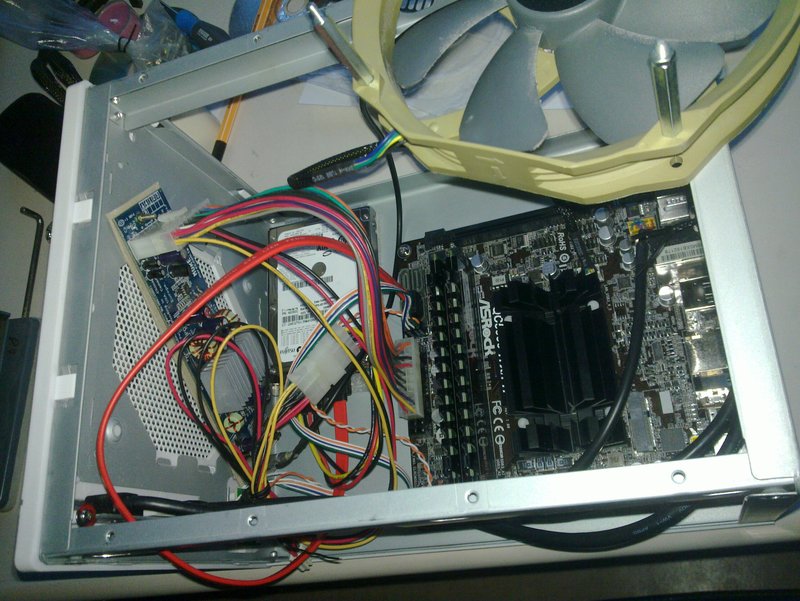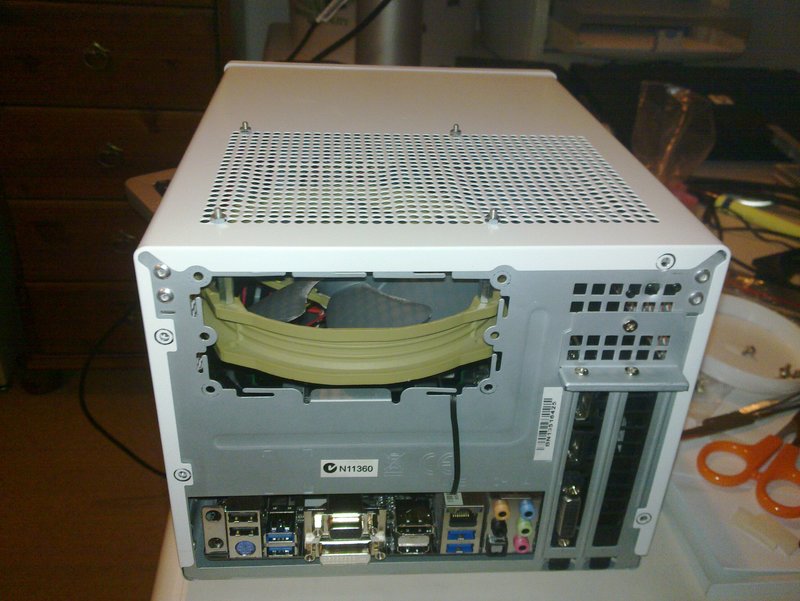
[2017-03-05] A luggable machine with a decent GPU and cooling. Bought the mobo anew on 2016-09-06.
[2018-08-05] After I bought a more portable "gaming" laptop for my art gigs, this machine still has some benefits over laptops:
[2020-10-05] Having sold and moved around some GPUs, this has been running APU-only for some time. It remains quite capable as a backup media player, since the AMD GPU handles H.264 decoding via both vdpau and vaapi using opensource drivers. It's also good to have different implementations of OpenGL to test my math-art code.
| CPU temperature monitor | k10temp | lm_sensors |
| CPU frequency scaling | acpi_cpufreq | |
| Ethernet | r8169 | |
| Graphics | nvidia, amdgpu | fglrx and radeon also work for the APU, but with lower performance |
| Sound | Intel HDA, Realtek ALC892 |
TurionPowerControl doesn't work: "No supported processor detected, sorry."
See Hoo.
The A4-5000 is surprisingly capable, easily beating my Intel laptops in many workloads, with a lower TDP. There are 4 full cores and instructions like AES and AVX.
Similarly to Hoo.
The CPU/SoC provides 2 USB3 ports, which would be plenty for me, but the mobo also includes an Etron EJ188H chip for 4 more. This gives a total of 4x USB3 on the back and 2 in a header.
With AMD's fglrx, testing my OpenGL demos shows similar performance to Intel HD Westmere, which is not that great — I need much more if I'm going to lug this around. Which is what the Nvidia is for.
Unfortunately, this general Linux issue still applies: a closed GPU driver cannot run along with other GPU drivers. Of course, with a strong discrete GPU, the APU is relatively useless when it comes to computing power. But there's a lot of nice display hardware going unused, lots of multi-monitor opportunities wasted, that could be useful for less GPU-heavy tasks.
[2017-03-06] As for opensource drivers for the AMD GPU, both the old Radeon and the new AMDGPU support this Kabini chip. I generally compile these in the kernel to make a smoother startup console, in which case the firmware blobs must be included too. Both seem to work with the basic instructions; note that the firmware blobs are also different. The Radeon driver is quite poor with OpenGL, but AMDGPU is pretty decent, considerably better than fglrx.
With the AMDGPU (and Radeon) driver comes also the VDPAU interface to video decoding, so H.264 files will play smoothly. This is much better supported than the VAAPI/XvBA interface of fglrx, for instance by MPlayer.
[2017-03-13] There is also AMDGPU-PRO, a closed extension to AMDGPU that provides OpenCL and Vulkan support, and possibly faster OpenGL. However, it seems to be limited to the R[79X] series.
[2018-08-30] I now have AMDGPU working simultaneously with Nvidia binaries, to some extent. Some problems remain:
As with Hoo, this is not a truly fanless machine if you actually use full CPU/APU performance. I am currently using a TY-140 fan connected to the CPU fan socket, which is silent enough to my tastes.
[2017-03-26] The setup has been nice and quiet in a full tower case, but I recently got a Mini-ITX case, as I need some GPU power on the go — much cheaper than a gaming laptop. I found a cheap, used Sugo Lite, but it needed some heavy modding to get the cool and quiet right.
The case fan was noisy and inefficient. Removing the extra "filter" mesh improved things a little, but there was still too much noise, and too little airflow on the CPU. So I removed the stock fan, and in the process had to reorganize almost everything. Out went the drive bays and in came my trusty old TY-140 fan, which now took up considerable space. The PSU and the HD had to be relocated. There were also questions about mounting, as there was enough space for everything but all the official mounts were gone.
In an amazing stroke of luck, new mounting ideas popped up: the Morex PSU would fit exactly in the diagonal of the stock fan screw-holes. In addition, the top case has just enough perforations to attach the TY-140 (with its 120 mm mounting span). There was no obvious solution for the HD, but with enough floor space, I simply used some foam padding and 2-sided tape, along with a laptop HD bay to keep the HD clear of the tape.

The only slightly tricky bit was that with the TY-140 in place, the outer case would not slide on or off. But with the fan protruding slightly outside the case, it could be nudged into place after the outer case was fully on.

One remaining annoyance is the blue LEDs, which light up the whole room at night. Replacing at least the power LED should help, as it is much brighter of the two. Incidentally, the front-panel connectors were also getting in the way; the USB3 cables could not be hooked up, lest they hit the fan. So I removed the entire assembly, and the audio jack hole was perfect for a LED.

Inspired by the GEB book via Bridges 2016 conference, as I plan to use this in art shows, and the fact that there might be more in the future.